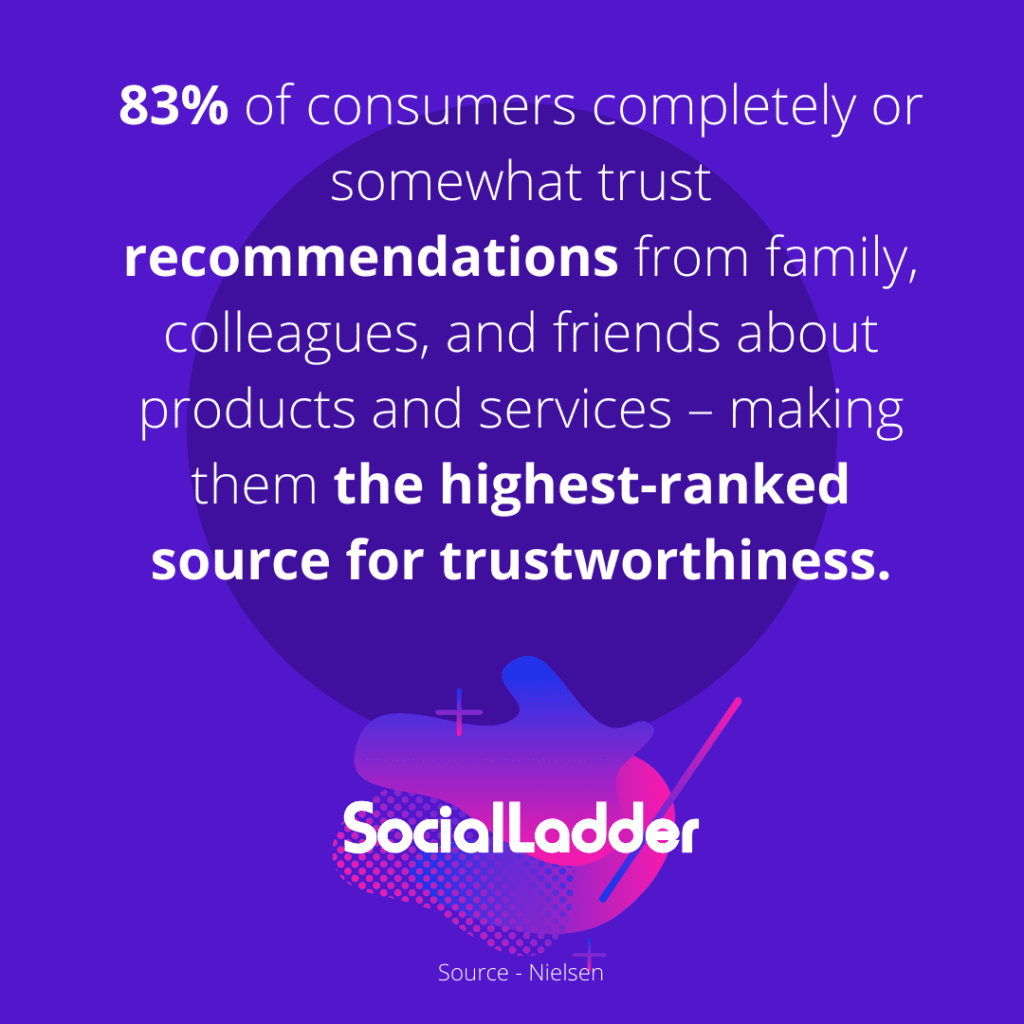In this article, you will learn exactly what is word of mouth marketing and what are the different approaches you can take. All in hopes of helping you get started in harnessing the power of people.

People love to tell others about positive experiences with brands. And people also trust these opinions more than traditional advertising. Which is why word of mouth marketing strategies have become so popular.
If this is a new concept for you, then you might be confused about what qualifies as a word of mouth marketing strategy. After all, people recommending products is something that happens organically and there isn’t much a brand can do, right?
Actually, brands can do a lot to encourage, incentivize and influence recommendations, that’s what WOM marketing is all about.
Over the years word of mouth marketing has evolved, and it now takes multiple forms — all of which are similar but apply different approaches to customer acquisition.
In order to start a word of mouth marketing strategy, you first need to understand exactly what is WOM marketing and what are the types. By knowing this you will be one step closer to implementing a successful strategy that is perfect for your brand.
Let’s get started.
What is word of mouth marketing?
Word of mouth marketing is any activity from a brand with the purpose of increasing positive recommendations from people to their network. This includes organic and paid instances of word of mouth recommendations.
Some people also call it word of mouth advertising, but it means the same thing.
In the most basic way, WOM is organic recommendations from regular people to their friends and family. When marketers figured out how powerful those recommendations were, brands started to put effort into building relationships with their customers to promote them.
There are many ways for encouraging natural WOM like online reviews and user generated content, but there are other strategies that can be ideal for your brand as well.
In general, a combination of different approaches will give you the best results.
Below are some of the different types of word of mouth advertising that you might have heard about.
But first, let’s look at the reasons why you need a word of mouth marketing strategy.
Why your brand needs word of mouth marketing
WOM marketing humanizes brands. Traditional advertising suffers from that authentic touch.
Especially when there are so many examples of false advertising. In fact, only 25% of people consider advertisements to be true.
Considering that 92% of consumers trust recommendations from family and friends, it should be a priority to implement a strategy that takes customers into account.
Another study showed the following:

No matter the model you utilize, having people recommend your brand has a lot of power.
It’s clear that people trust what others have to say about a brand, even more than traditional advertising. So making sure that customers have good things to say about your brand is a great way to grow your brand organically.
In addition, the following approaches are proven to increase brand trust, awareness, and sales thanks to trustworthy carriers of your brand’s message.
These are some of the strategies your brand should consider:
Referral Marketing
Referral marketing is a way for brands to incentivize passionate customers in exchange for spreading their love of your brand to their friends and family.
This form of marketing creates a win-win situation because it benefits both the customer as well as the brand — the customer provides the extra traffic and sales, and the brand provides the customer with rewards that drive brand loyalty.
To put it simply, referral marketing is when a brand encourages its customers to recommend a product or service to their close circle of friends and family through a referral program.
Some of the rewards that can be offered in exchange for referrals are:
- Coupons
- Store credit or points
- Company merchandise
- Gift Cards
- Charitable donations
- Discounts on product and/or orders
Referral marketing works thanks to pre-established trust and relationships between your biggest customers and their friends and family.
In addition, customers are incentivized to get more referrals to get more rewards.
Affiliate Marketing
In contrast, affiliate marketing relies on people (who may or may not be customers) — often publishers with a large reach or distribution — to drive customers to you through their own marketing efforts.
An affiliate marketer earns a percentage-based commission according to the number of leads or sales they are able to generate through link sharing and promotion.
No leads or sales = no payment.
This form of marketing works as an effective and reliable way to drive extra leads, sales, and data, beyond the brand’s initial marketing research.
Affiliate marketing is becoming more popular, with 81% of brands using this strategy to drive brand awareness and conversions.
For brands, an affiliate program is still a cost effective growth strategy compared to traditional advertising.
Influencer Marketing
Influencer marketing is similar to affiliate marketing in concept but very different in practice.
While affiliate marketing practices use multiple volunteer affiliates with varying followings to generate as much attention as they can within their limited networks, influencer marketing consists of a brand seeking out an individual with a social media following to promote the brand to their network, typically on a pay-per-post basis.
The main difference between influencer marketing and other types of word of mouth is that partnerships are usually short term and campaign based.
In a typical influencer marketing campaign, influencers only have to create and post 1 or 2 pieces of content.
This type of social media marketing is great for brands looking for awareness. This is due to the fact that influencers typically have a larger following compared to normal people. If the influencer is chosen correctly, the brand can connect with his or her audience and spark the interest of potentially millions of people.
However, it’s important to have in mind that sometimes more followers don’t mean better results. Influencers with small audiences are also valuable because they have stronger connections with their followers. Making them more influential for purchasing decisions. Almost like a friend.
Consider your goals before making the mistake of choosing an expensive influencer with an audience who won’t connect with your brand.
Brand Ambassador Marketing
Another strategy that many companies use with great results is brand ambassador marketing.
A brand ambassador is someone chosen by a brand to represent them and promote their products or services through social media platforms or in-person activities.
Usually, these people are chosen because they are passionate customers who are already promoting the brand. They can be customers, employees, influencers, students, etc.
As we mentioned before, brand trust is a very important factor for purchasing decisions. By strategically inviting people that are part of your target audience to become ambassadors, your brand gets recommended to ideal customers from a trusted face.
Just as micro-influencers, their influence over their network is powerful. This is why a brand ambassador program is great at driving brand awareness and referrals. Even if they don’t have a massive following.
Brand ambassadors are all about marketing through authentic interactions.
In a way, it’s like referral marketing, however, compensation is different. Some ambassadors aren’t even looking for rewards, they just want to spread the love for your brand. This makes this strategy one of the truest forms of WOM marketing.
Partner Marketing
Partner marketing, similar to referral marketing, is all about capitalizing on communities of potential customers that you wouldn’t typically have access to.
What does that mean?
It means that brands can partner with other brands to share each other’s networks.
By partnering with another business to run cross-promotions, brands are able to build lasting and mutually beneficial relationships, while boosting their awareness between similar customer bases.
Final thoughts
Word of mouth advertising is the best way to increase trust and loyalty while building an authentic relationship with customers.
Not to mention that it is also an extremely cost effective alternative compared to other advertising methods.
It is no secret that traditional advertising has become less and less reliable over the past decade.
As consumers become more informed and skeptical of traditional ads, it has become increasingly important for brands to build more authentic relationships with the consumers they are trying to reach.
The strongest way to do that is by utilizing these approaches.



